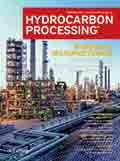
February 2019
Special Focus: Materials Manufacturing
For pressure vessels, heat exchangers and piping in corrosive services, the materials in contact with the process are often required to be high alloys to provide a reliable service life.
Duplex materials have been around for a long time.
Plate and frame (P&F) heat exchangers were first manufactured 100 yr ago for use in the dairy industry.
Process Optimization
Part 1 of this article, which appeared in the January 2019 issue of Hydrocarbon Processing, discussed how new plant construction includes expectations for optimized production performance to achieve targeted profitability.
The first-generation, proprietary feed distributorsa had open-pipe bayonets that were located at the base of the wye section/riser.
The European TOP-REF research consortium has developed and applied a methodology to improve the resource efficiency of industrial production processes.
Maintenance and Reliability
The pumps referred to in this article are 2,600-HP vertical pumps utilized as booster pumps for the shipment of crude oil.
Refineries cannot afford a sudden boiler failure (FIG. 1). Regularly assessing the condition of boilers is vital.
A reboiler provides the necessary heat duty for the separation in a distillation tower.
Project Management
Large capital projects continue to be challenged by budget issues.
Environment and Safety
On November 30, 2013, an explosion and fire occurred at the UCB Farchim SA site in Switzerland. Fortunately, no injuries or fatalities occurred.
Before discussing failure causes, it is helpful to understand why the idea of process safety management (PSM) has taken hold in the past few decades.
Columns
Refineries and petrochemical plants contain some of the harshest environments on the planet.
The application of wireless sensors to monitor process pump hydraulic performance and defect progression in the power end of pumps is of interest to pump users.
In the oil and gas industry, time is money.
South Sudan has one of the largest proven oil reserves in sub-Saharan Africa.
During an engineer’s career, many interesting questions come up that may not have a ready or good answer.
Innovations continue to evolve at a steady pace.
In today’s business and regulatory environment, controlling a refinery or other high-hazard processing plant is increasingly demanding.
In the wake of Hurricane Florence, businesses across the US had another reminder of how unpredictable and unavoidable disasters are when they strike.
Europe’s refiners, through their industry organization Fuels Europe, have set out their long-term ambitions in a new program called Vision 2050.
The oil and gas industry is becoming increasingly digitized—but is it improving its cybersecurity measures to match?
Trends & Resources
To continue communication and feedback with <i>Hydrocarbon Processing</i>’s global audience, the editors have posted a new poll to HydrocarbonProcessing.com.
The 2018 edition of Petrotechnics’ process safety management (PSM) and operational risk management report builds on insights gained from the 2017 survey.
US refinery margins saw losses as product stocks rose, pressured by seasonally lower gasoline demand and subdued heating oil requirements.
According to <i>Hydrocarbon Processing’</i>s Construction Boxscore Database, more than 320 new downstream capital projects have been announced over the past year.

- Digital Exclusive: Root cause analysis on hydrochloric acid corrosion in a diesel hydrotreater unit 12/16
- Digital Feature: Enabling growth through strategic cost optimization for petrochemical and refining companies 12/16
- Rohm awards NextChem feasibility study for PMMA-polymer chemical recycling plant project 12/16
- Westlake to rationalize certain North American chlorovinyl and styrene assets 12/16
- CMB.TECH invests in Chinese ammonia supply 12/16
- Petrovietnam, BASF cooperate in developing green methanol, pioneering the energy transition 12/16




